Russian Revolution
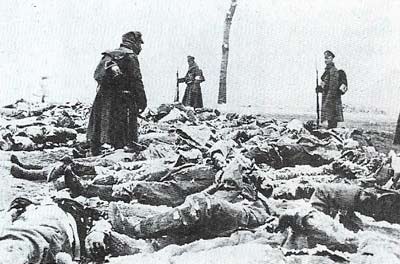
Figure 1. Russia paid a fearful price in human life for her incompetence in waging a long modern war. More than 15 million men had been mobilized by mid-1917. About 1.7 million men perished on the battlefield, 4.9 million were wounded and 2.4 million were taken prisoner. Russia was superior in strength to Turkey, Bulgaria and Austria-Hungary, but was outmatched by their ally Germany.
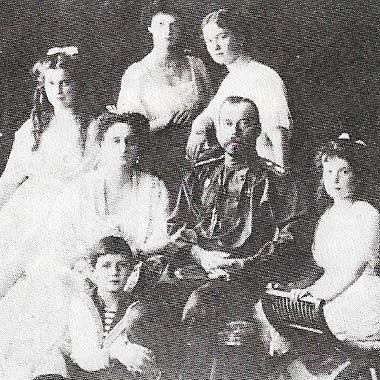
Figure 2. 15 March 1917 Tzar Nicholas II, shown here with his family, was persuaded to abdicate and the first provisional government was formed in Petrograd.
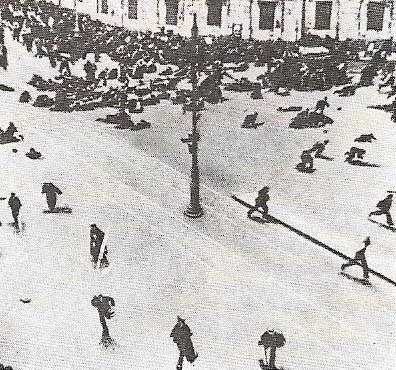
Figure 3. Clashes broke out in Petrograd on 16–18 July 1917 when armed workers demonstrated for "All power to the Soviets" but were suppressed by the government.
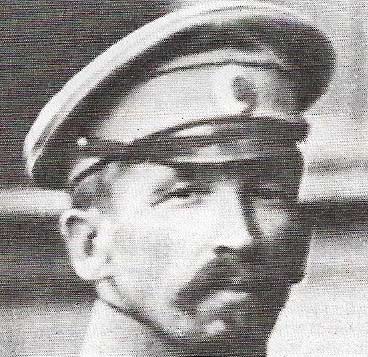
Figure 4. General L. G. Kornilov 1870–1918), Kerensky's commander-in-chief, marched his troops on Petrograd in August 1917. This was seen by Kerensky as a right-wing attempt to take power and he turned to the Bolsheviks for help. The plot dissolved but it emphasized the growing political divisions that Kerensky could no longer bridge.
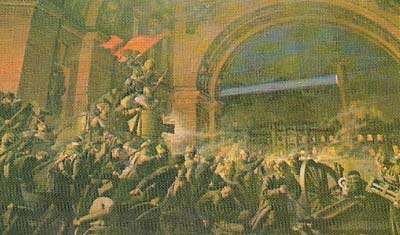
Figure 5. The Winter Palace was taken by the Bolsheviks on 7 November 1917. Lenin had secretly returned to Petrograd to forward Bolshevik plans for the overthrow of the provisional government, the collapse of which seemed imminent as unrest mounted. With the almost a bloodless seizure of the palace, Kerensky fled and other members of the provisional government were arrested.
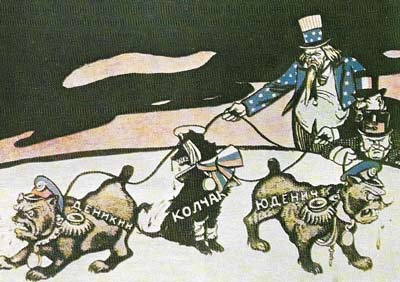
Figure 6. Civil war divided Russia from 1918–1920, threatening Bolshevik rule. In March 1918 Germany had forced Russia to disadvantageous peace settlement at Brest-Litovsk. However, allied troops then came to Russia to prevent German forces occupying key centers. After Germany's defeat they stayed and aided the Whites during the civil war. The Bolsheviks, who had mobilized the imperial army by granting land to the peasants and seeking a separate peace, had to create a new force, the Red Army. Trotsky, the father of the Red Army, was a brilliant military leader. The Reds had to contend with Greens (anarchists), Poles and dissident nationalities and the British, Americans, Japanese and French scattered around the country. The cartoon shows Uncle Sam about to release the dogs of war: the White leaders Denikin, Kolchak and Yudenich.
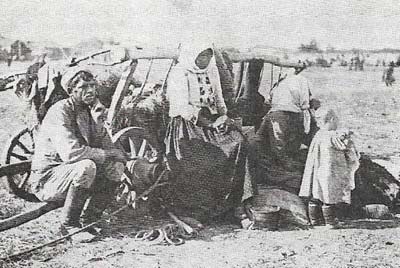
Figure 7. The famine that devastated the Volga region in the winter of 1921–1922 claimed about 5 million lives and came on top of the virtual collapse of the Russian economy in 1921. By the end of 1920, the defeat of the Whites and the withdrawal of the Allies was complete. But seven years of war had left Russia in chaos, and popular unrest was fermented by inflation, shortages of food and fuel and increasingly autocratic measures introduced to deal with internal and external threats to the infant Soviet state. Lenin introduced the New Economic Policy in 1921 to stimulate the economic reconstruction and to placate the peasants by allowing a limited market economy with greater freedom of production. The period of the NEP was also one of considerable freedom expressed in the arts.
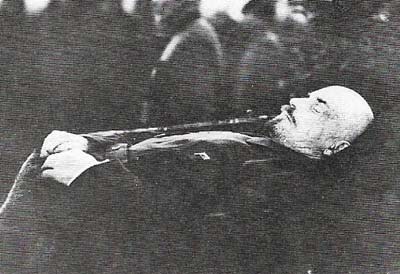
Figure 8. Lenin's death in 1924 followed a stroke in 1922, at which time a troika of Zinoviev (1883–1883), Kamenev (1883–1936), and Stalin had been established to continue the leadership. Lenin distrusted Stalin, whose main rival for the succession was Trotsky. But by skillfully playing of various factions and by control of the party mechanism, Stalin isolated Trotsky by 1925 and moved towards personal domination and ultimate dictatorship.
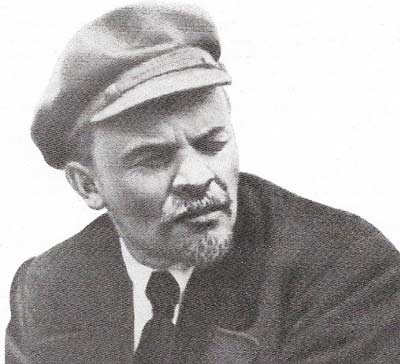
Figure 9. Vladimir Ilyich Ulyanov (known as Lenin) was born in Simbirsk (now Ulyanov) on the Volga. He was mainly in exile from 1900, but returned for the Revolution of 1917.
Russia went reluctantly to war in 1914. Her army was in no condition to face imperial Germany and early enthusiasm for the war waned with a shattering defeat by the Germans at Tannenberg within a month of hostilities commencing. But only the Bolsheviks vehemently opposed the war, the five Bolshevik deputies in the Duma (Parliament) being banished to Siberia. Their leader, Vladimir Ilyrich Lenin (1870–1924), nevertheless saw the defeat of imperial Russia as the surest way of furthering revolutionary goals.
Impact of the February Revolution
The longer hostilities lasted, the more incompetent the imperial administration appeared. It was astonished by the revolution in March 1917 (dated as February by the old-style calendar), but then so were its opponents. Power was transferred, by hungry peasants, disenchanted aristocracy and mutinous troops, from Tsar Nicholas II (1868–1918) (Figure 2) to a provisional government that was intended to be a temporary, caretaker administration until a Constituent Assembly adopted a constitution and appointed a legal government. The first provisional government (there were four in all) fell because of its failure to end the war.
Peace and the redistribution of land were closely connected. If Russia left the war, the soldiers (who were mostly peasants in uniform) would descend on the countryside and demand more land; if the peasants were granted land while war continued, the soldiers would desert to seize their portion. The government had also to contend with the emergence of genuinely democratic institutions, the soviets (councils). The most famous of these were in Petrograd and in Moscow, but they sprang up spontaneously everywhere after the revolution. Despite support from the moderate socialists – the Mensheviks and the Socialist Revolutionaries (SRs) – the provisional governments were violently opposed by Lenin and the Bolsheviks. During July, armed workers and soldiers tried to seize power in Petrograd (Figure 3). Denounced for accepting German money, Lenin was forced to flee to Finland when the demonstrations were unsuccessful. On 22 July, Alexander Kerensky (1881–1970) became premier and tried to restore order in the capital (Figure 4). But Leon Trotsky (1879–1940), a leading figure in the Petrograd soviet, organized armed insurrection under the cover of soviet legitimacy. Lenin slipped back into Russia and on 7 October (25 November, old style) he and his Bolsheviks (Figure 5) swept away Kerensky.
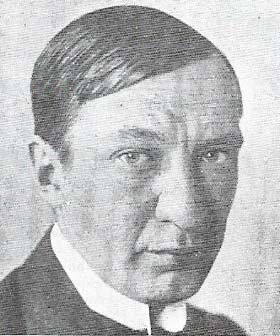 |
| Alexander Kerensky played a major role in shaping policies of the provincial governments in 1917. He was a minister in the first two provisional governments, prime minister from July onwards, and after he had suppressed an army revolt in September he also took over as commander-in-chief. His failure to solve the twin problems of land and peace pave the way for Lenin's victory in October. |
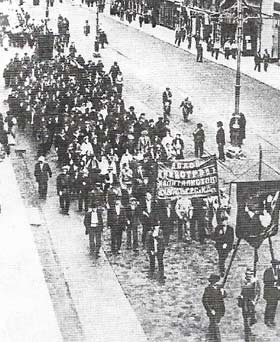 |
| Demonstrations during the "April Days", 1917, against the war led to the fall of the first provisional government and the resignation of Foreign Minister Milyukov (1859-1943). But Russia's war effort continued, and in the soviets support for the Bolsheviks grew at the expense of the moderates. Calling for peace and a complete transfer of power to the soviets, further demonstrations in June showed the growing influence of the Bolsheviks and the declining support for the provisional government. |
The October Revolution and after
Some workers hoped that the new Russia would be ruled by the soviets but events soon dictated otherwise. Given their narrow political base (there were fewer than 300,000 Bolsheviks in November 1917), Lenin and his supporters faced widespread opposition on every front. There were those who advocated a revolutionary war to advance socialism in the rest of Europe; there were Bolsheviks who wanted money abolished and a socialist economy overnight; there were the peasants who wanted to be left alone with the land now redistributed; and there were the dispossessed of the former regime.
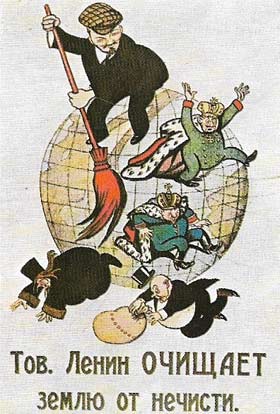 |
| "Comrade Lenin sweeps the world of its rubbish" in this early Soviet cartoon. Peace and land were the two major demands Lenin promised to meet and immediately and seizing power the Bolsheviks put into effect the land policy they had adopted from the Socialist Revolutionaries. Land was later nationalized, but in 1917 most peasants still regarded it as their own. During the civil war grain was forcibly requisitioned to feed the Red Army and the cities. The peasants planted less and there was famine and disease. Finally Lenin capitulated and introduced the New Economic Policy in 1921. |
The treaty of Brest-Litovsk in March 1918 ended the war with Germany; in the summer of the same year civil war broke out between the "Reds" (the Bolsheviks) and the "Whites" (anti-communists). In the autumn, the Allies intervened in an attempt to reestablish the eastern front (Figure 6), and soon began assisting the Whites. Hostilities lasted until the end of 1920 and revealed two victors, the Red Army and the Communist Party. During this time the Bolsheviks murdered the imprisoned tsar and his family. The Reds had the advantage of a claim that they were defending Russia from invasion. The desperate measures needed to secure military victory alienated many workers and peasants. Although desertions from the Red Army were frequent, Trotsky was successful in forging Soviet military might, but democracy fell victim to the needs of the hour. Lenin fashioned a new force to rule the country, the Communist Party of the Soviet Union. Aided by the feared Cheka (a secret police force), the Party and the military were willing to obey Lenin and his colleagues, while the soviets would not.
The bloodshed and exhaustion of seven years of war left Soviet Russia racked by revolt. Lenin gave way to the peasants and in 1921 introduced the New Economic Policy (NEP) which temporarily relaxed socialism in favor of some private ownership. The "commanding heights of the economy" stayed in state hands but agriculture, employing 80 percent of the population, was on a market basis. The economy thus gradually recovered under the NEP.
The emergence of the new Russia
Soviet Russia had to be satisfied with less territory than the old empire held. The borderlands – Finland, Estonia, Latvia, Lithuania, Poland, part of the Ukraine and Bessarabia – were lost. But in the three independent Transcaucasian republics, following the British evacuation of Transcaucasia in December 1919, the way was clear for the Bolsheviks to take over. By April 1921 Transcaucasia was back in the fold thanks to the activities of the Red Army.
There remained the problem of succession. Lenin expected Trotsky to succeed him but ultimately Joseph Stalin (1879–1953) proved the more ruthless politician.
